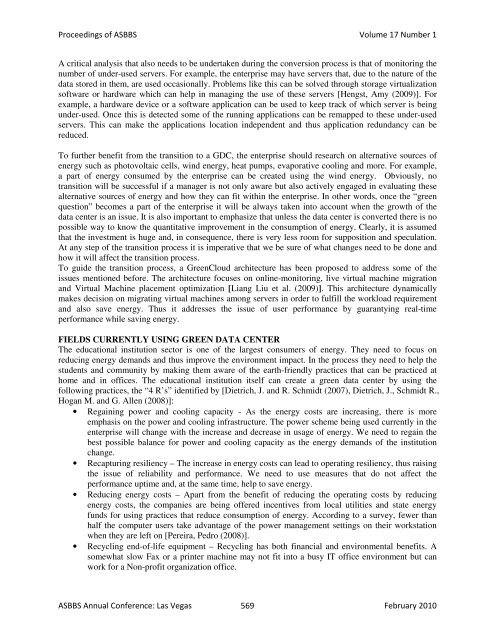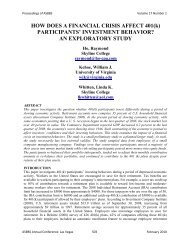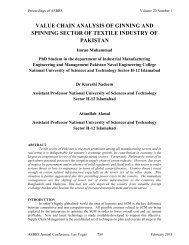GREEN DATA CENTER: HOW GREEN CAN WE ... - Asbbs.org
GREEN DATA CENTER: HOW GREEN CAN WE ... - Asbbs.org
GREEN DATA CENTER: HOW GREEN CAN WE ... - Asbbs.org
Create successful ePaper yourself
Turn your PDF publications into a flip-book with our unique Google optimized e-Paper software.
Proceedings of ASBBS Volume 17 Number 1<br />
A critical analysis that also needs to be undertaken during the conversion process is that of monitoring the<br />
number of under-used servers. For example, the enterprise may have servers that, due to the nature of the<br />
data stored in them, are used occasionally. Problems like this can be solved through storage virtualization<br />
software or hardware which can help in managing the use of these servers [Hengst, Amy (2009)]. For<br />
example, a hardware device or a software application can be used to keep track of which server is being<br />
under-used. Once this is detected some of the running applications can be remapped to these under-used<br />
servers. This can make the applications location independent and thus application redundancy can be<br />
reduced.<br />
To further benefit from the transition to a GDC, the enterprise should research on alternative sources of<br />
energy such as photovoltaic cells, wind energy, heat pumps, evaporative cooling and more. For example,<br />
a part of energy consumed by the enterprise can be created using the wind energy. Obviously, no<br />
transition will be successful if a manager is not only aware but also actively engaged in evaluating these<br />
alternative sources of energy and how they can fit within the enterprise. In other words, once the “green<br />
question” becomes a part of the enterprise it will be always taken into account when the growth of the<br />
data center is an issue. It is also important to emphasize that unless the data center is converted there is no<br />
possible way to know the quantitative improvement in the consumption of energy. Clearly, it is assumed<br />
that the investment is huge and, in consequence, there is very less room for supposition and speculation.<br />
At any step of the transition process it is imperative that we be sure of what changes need to be done and<br />
how it will affect the transition process.<br />
To guide the transition process, a GreenCloud architecture has been proposed to address some of the<br />
issues mentioned before. The architecture focuses on online-monitoring, live virtual machine migration<br />
and Virtual Machine placement optimization [Liang Liu et al. (2009)]. This architecture dynamically<br />
makes decision on migrating virtual machines among servers in order to fulfill the workload requirement<br />
and also save energy. Thus it addresses the issue of user performance by guarantying real-time<br />
performance while saving energy.<br />
FIELDS CURRENTLY USING <strong>GREEN</strong> <strong>DATA</strong> <strong>CENTER</strong><br />
The educational institution sector is one of the largest consumers of energy. They need to focus on<br />
reducing energy demands and thus improve the environment impact. In the process they need to help the<br />
students and community by making them aware of the earth-friendly practices that can be practiced at<br />
home and in offices. The educational institution itself can create a green data center by using the<br />
following practices, the “4 R’s” identified by [Dietrich, J. and R. Schmidt (2007), Dietrich, J., Schmidt R.,<br />
Hogan M. and G. Allen (2008)]:<br />
• Regaining power and cooling capacity - As the energy costs are increasing, there is more<br />
emphasis on the power and cooling infrastructure. The power scheme being used currently in the<br />
enterprise will change with the increase and decrease in usage of energy. We need to regain the<br />
best possible balance for power and cooling capacity as the energy demands of the institution<br />
change.<br />
• Recapturing resiliency – The increase in energy costs can lead to operating resiliency, thus raising<br />
the issue of reliability and performance. We need to use measures that do not affect the<br />
performance uptime and, at the same time, help to save energy.<br />
• Reducing energy costs – Apart from the benefit of reducing the operating costs by reducing<br />
energy costs, the companies are being offered incentives from local utilities and state energy<br />
funds for using practices that reduce consumption of energy. According to a survey, fewer than<br />
half the computer users take advantage of the power management settings on their workstation<br />
when they are left on [Pereira, Pedro (2008)].<br />
• Recycling end-of-life equipment – Recycling has both financial and environmental benefits. A<br />
somewhat slow Fax or a printer machine may not fit into a busy IT office environment but can<br />
work for a Non-profit <strong>org</strong>anization office.<br />
ASBBS Annual Conference: Las Vegas 569<br />
February 2010

















